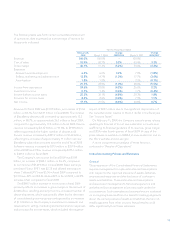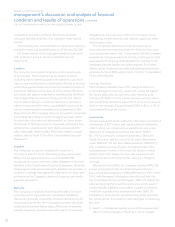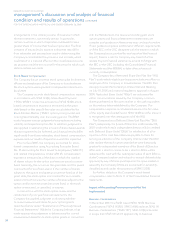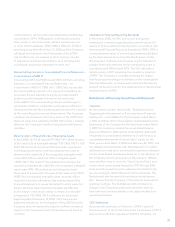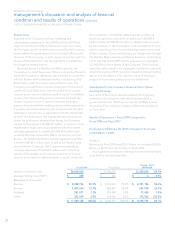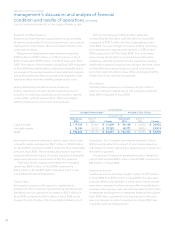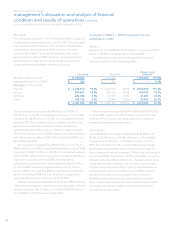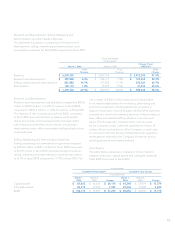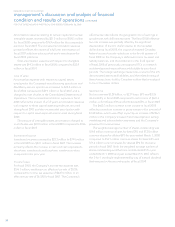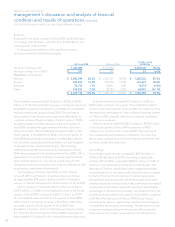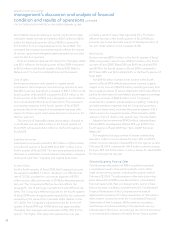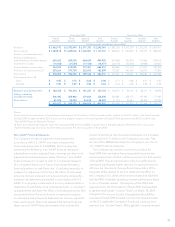Blackberry 2009 Annual Report Download - page 31
Download and view the complete annual report
Please find page 31 of the 2009 Blackberry annual report below. You can navigate through the pages in the report by either clicking on the pages listed below, or by using the keyword search tool below to find specific information within the annual report.
29
majority of the increase was attributable to maintenance
and CALs, offset by a decrease in BES and other software
revenues.
Other revenue, which includes accessories, non-warranty
repairs, NRE and gains and losses on revenue hedging
instruments, increased by $175.3 million to $321.0 million in
fiscal 2009 compared to $145.8 million in fiscal 2008. The
majority of the increase was attributable to increases in
non-warranty repair, gains realized from revenue hedging
instruments and sales of accessories. See “Market Risk of
Financial Instruments – Foreign Exchange” for additional
information on revenue hedging instruments.
Gross Margin
Consolidated gross margin increased by $2.02 billion, or
65.5%, to $5.10 billion, or 46.1% of revenue, in fiscal 2009,
compared to $3.08 billion, or 51.3% of revenue, in fiscal
2008. The decrease of 5.2% in consolidated gross margin
percentage was primarily due to a decrease in the blended
device margins primarily driven by the introduction of
certain new feature rich products that incorporate new
technologies which were adopted at a faster rate than
historically, lower than anticipated unit shipments of previous
generation products, and a higher percentage of device
shipments which comprised 82.1% of the total revenue mix
in fiscal 2009 compared to 79.4% in fiscal 2008. Gross margin
percentage for devices is generally lower than the Company’s
consolidated gross margin percentage. The decrease in gross
margin percentage relating to devices was offset in part by
improved service margins resulting from cost efficiencies
in RIM’s network operations infrastructure as a result of the
increase in BlackBerry subscriber accounts.
Research and Development, Selling, Marketing and
Administration, and Amortization Expense
The table below presents a comparison of research and
development, selling, marketing and administration, and
amortization expenses for fiscal 2009 compared to fiscal 2008.
Device revenue increased by $4.32 billion, or 90.6%, to $9.09
billion, or 82.1% of consolidated revenue, in fiscal 2009
compared to $4.77 billion, or 79.4%, of consolidated revenue
in fiscal 2008. This increase in device revenue over the prior
year was primarily attributable to a volume increase of
approximately 12.2 million units, or 88.7%, to approximately
26.0 million devices in fiscal 2009 compared to approximately
13.8 million devices in fiscal 2008. ASP increased to $349 in
fiscal 2009 from $346 in fiscal 2008 due primarily to a change
in the BlackBerry device mix of certain new products that
are feature rich and designed to operate on new network
technologies. The Company currently expects ASP to be
lower in fiscal 2010 when compared to fiscal 2009, as RIM
expands its market focus into the consumer market and as
the technology continues to mature. ASP is dependent on a
number of factors including projected future sales volumes,
device mix, new device introductions for the Company’s
enterprise, prosumer and consumer offerings as well as
pricing by competitors in the industry.
The Company estimates that a $10, or 2.9%, change in
overall ASP would result in a fiscal year revenue change of
approximately $260 million, based upon the Company’s
volume of devices shipped in fiscal 2009.
Service revenue increased by $541.9 million, or 63.0%, to
$1.40 billion or 12.7% of consolidated revenue in fiscal 2009
compared to $860.6 million, or 14.3% of consolidated revenue
in fiscal 2008, reflecting the Company’s increase in BlackBerry
subscriber accounts since fiscal 2008. Net BlackBerry
subscriber account additions were approximately 11 million
for fiscal 2009 compared to approximately 6.1 million for fiscal
2008. The total BlackBerry subscriber account base at the
end of fiscal 2009 was approximately 25 million compared
to approximately 14 million at the end of fiscal 2008. The
percentage of the subscriber account base outside of North
America at the end of fiscal 2009 was approximately 32%.
Software revenue includes fees from licensed BES software,
CALs, technical support, maintenance and upgrades.
Software revenue increased $17.5 million, or 7.5%, to $251.9
million in fiscal 2009 from $234.4 million in fiscal 2008. The
Fiscal Year Ended
(in thousands)
February 28, 2009 March 1, 2008 Change - Fiscal
2009/2008
% of
Revenue % of
Revenue % of
Change
Revenue $ 11,065,186 $ 6,009,395 $ 5,055,791 84.1%
Research and development $ 684,702 6.2% $ 359,828 6.0% $ 324,874 90.3%
Selling, marketing and administration 1,495,697 13.5% 881,482 14.7% 614,215 69.7%
Amortization 194,803 1.8% 108,112 1.8% 86,691 80.2%
$ 2,375,202 21.5% $ 1,349,422 22.5% $ 1,025,780 76.0%


